In Victorian times, the area in which this Wetherspoon pub is situated was known as ‘The Tumble’, from the horse-drawn carts which often overturned as they journeyed to and from the pits. The Tumble, with its innumerable inns, was the heart of the town. The Half Moon, which stood opposite this site until 1989, was said to be the most frequented bar in Wales. The New Inn is also well remembered. A farmhouse in the 1730s, the New Inn became a post house and then a famous hotel, until it was demolished in 1982.
Text about The Tumble Inn.
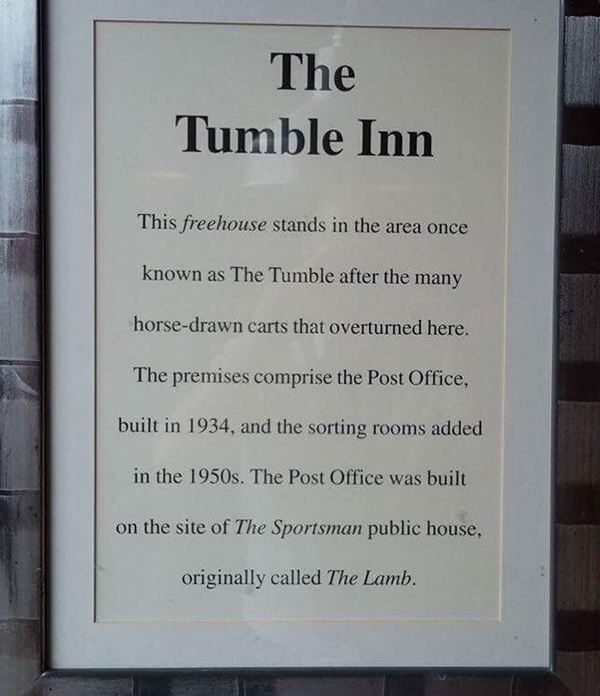
The text reads: This freehouse stands in the area once known as The Tumble after the many horse-drawn carts that overturned here. The premises comprise the post office, built in 1934, and the sorting rooms added in the 1950s. The post office was built on the site of The Sportsman public house, originally called The Lamb.
Prints and text about The Tumble Inn.
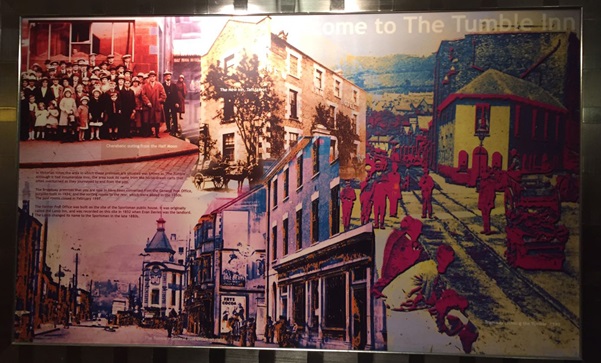
The text reads: In Victorian times the area in which these premises are situated was known as The Tumble. Although it had innumerable inns, the area took its name from the horse-drawn carts that often overturned as they journeyed to and from the pits.
The Broadway premises that you are now in have been converted from the general post office, purpose-built in 1934, and the sorting rooms to the rear, which were added in the 1950s. The post rooms closed in February 1997.
The former post office was built on the site of the Sportsman public house. It was originally called the Lamb Inn, and was recorded on this site in 1852 when Evan Davies was the landlord. The Lamb changed its name to the Sportsman in the late 1880s.
Prints and text about crossing the River Taff.
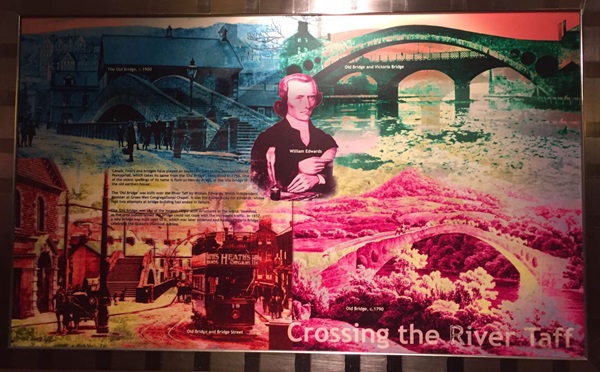
The text reads: Canals, rivers and bridges have played an important part in the development of Pontypridd, which takes its name from the ‘Old Bridge’, completed in 1756. One of the oldest spellings of its name is Pont-yr-Hen-dy-Pridd, or the ‘the bridge of the old earthen house’.
The Old Bridge was built over the River Taff by William Edwards, Welsh independent minister at Groes Wen Congregational Chapel. It was third time lucky for Edwards, whose first two attempts at bridge-building had ended in failure.
The Old Bridge was one of the longest single-arch structures in the world. However, as the area industrialised the bridge could not cope with the increased traffic. In 1857, a new bridge was built next to it, which was later widened and named Victoria Bridge to celebrate the Queen’s Diamond Jubilee.
Prints and text about the development of transport.
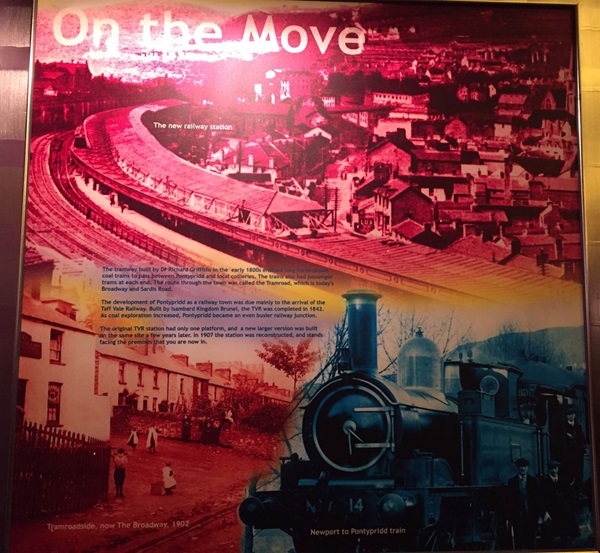
The text reads: The tramway built by Dr Richard Griffiths in the early 1800s enabled long horse-drawn coal trains to pass between Pontypridd and local collieries. The trains also had passenger trams at each end. The route through the town was called the Tramroad, which is today’s Broadway and Sardis Road.
The development of Pontypridd as a railway town was due mainly to the arrival of the Taff Vale Railway. Built by Isambard Kingdom Brunel, the TVR was completed in 1842. As coal exploration increased, Pontypridd became an even busier railway junction.
The original TVR station had only one platform, and a newer larger version was built on the same site a few years later. In 1907 the station was reconstructed, and stands facing the premises that you are now in.
Prints and text about famous Welsh voices.

The text reads: Written by John Hughes, a colliery clerk from Tonteg, the great Welsh hymn Cwm Rhondda was first sung at Hopkinstown, in 1907. Hughes had been inspired by the compositions of Dr Joseph Parry, which were often performed in Pontypridd.
Parry’s compositions were also well known in Cilfynydd. Situated on the outskirts of Pontypridd, the small village was the birthplace of the acclaimed baritone Sir Geraint Evans. It was also the home of the well-known lyric tenor Stuart Burrows.
Thomas Jones Woodward was born in July 1940, at 57 Kingsland Terrace, Treforest, near Pontypridd. In 1964 he released his first single as Tom Jones. It didn’t make the charts but it was the start of a phenomenally successful showbiz career.
Prints and text about industries in Pontypridd.
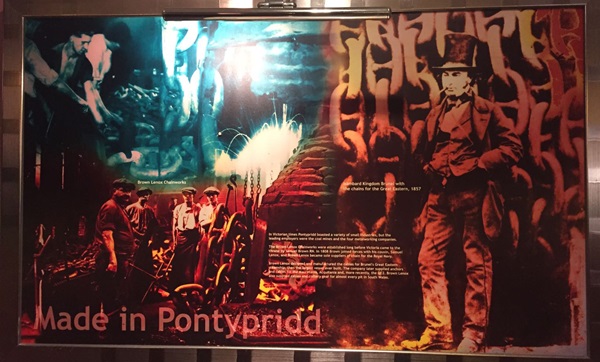
The text reads: In Victorian times Pontypridd boasted a variety of small industries, but the leading employers were the coal mines and the four metalworking companies.
The Brown Lenox Chainworks were established long before Victoria came to the throne by Samuel Brown RN. In 1808 Brown joined forces with his cousin, Samuel Lenox, and Brown Lenox became sole suppliers of chain for the Royal Navy.
Brown Lenox designed and manufactured the cables for Brunel’s Great Eastern steamship, then the largest vessel ever built. The company later supplied anchors and cables for the Mauretania, Acquitania and, more recently, the QE2. Brown Lenox also supplied cables and colliery gear for almost every pit in South Wales.
The text reads: In Victorian times Pontypridd boasted a variety of small industries, but the leading employers were the coal mines and the four metalworking companies.
The Brown Lenox Chainworks were established long before Victoria came to the throne by Samuel Brown RN. In 1808 Brown joined forces with his cousin, Samuel Lenox, and Brown Lenox became sole suppliers of chain for the Royal Navy.
Brown Lenox designed and manufactured the cables for Brunel’s Great Eastern steamship, then the largest vessel ever built. The company later supplied anchors and cables for the Mauretania, Acquitania and, more recently, the QE2. Brown Lenox also supplied cables and colliery gear for almost every pit in South Wales.
External photograph of the building – main entrance.
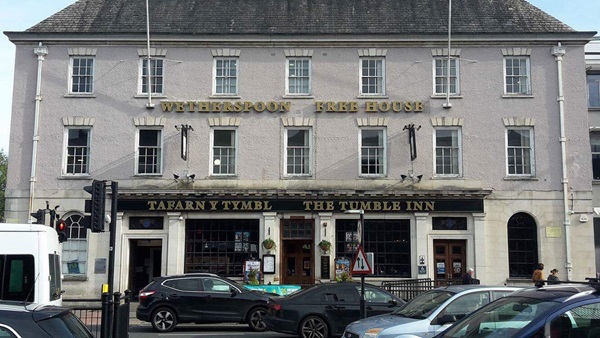
If you have information on the history of this pub, then we’d like you to share it with us. Please e-mail all information to: pubhistories@jdwetherspoon.co.uk